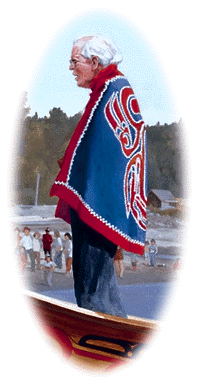| IN MEMORIAM: | (1920-1998) |
Biographical Notes
Upbringing and apprenticeship | Early work | Monumental works
Words and pictures | Bill Reid, 1920-1998 | His legacy
Bill Reid, 1920-1998
"The quality of Reid's work put (native art) back on the world scene."
Michael Ames, quoted in Pat Lush, "A transformer of existing things," Ryerson Rambler, no.28 (fall 1985), p.9"I make a living because I am an honest tradesman and put a lot into it. What I do are pastiches... They're in the style of the nineteenth-century Haida, but they're more than that. Once you get started there are channels to explore and there is no end of flexibility. A lot of emotional weight goes into them."
Bill Reid, quoted in Edith Iglauer, "The Myth Maker," Saturday Night, vol.27, no.2 (February 1982), p.20
Reid's first marriage was in 1944, by which he had a daughter who now lives at Skidegate. He met his third wife Martine in 1975, when she was pursuing her doctorate in anthropology at the University of British Columbia and consulted him about mounting a show of Northwest Coast art in her native France; they married in 1981.
 During his career, he received honorary doctorates from Simon Fraser University, the University of Victoria, York University, the University of Western Ontario, Trent University, the University of British Columbia, and the University of Toronto. His awards include:
During his career, he received honorary doctorates from Simon Fraser University, the University of Victoria, York University, the University of Western Ontario, Trent University, the University of British Columbia, and the University of Toronto. His awards include:
- the Canada Council's Molson Prize for cultural achievement (1976), one of Canada's highest tokens of recognition in this field
- the Diplôme d'Honneur (Canadian Conference of the Arts) for Service to the Arts (1979)
- Ryerson Fellowship (1985)
- the Bronfman Award for Excellence in Crafts (1986)
- the Royal Bank Award for Outstanding Canadian Achievement (1990)
painting: Gordon Miller
For over twenty-five years before his death, Reid had struggled with Parkinson's disease. At times he had only a few hours, or even minutes, of productive time in which he could directly become involved in sculpting. However, his mind and determination remained strong and he was able to proceed with his projects thanks to willing helpers, who sometimes put aside their own artistic endeavours in order to assist with Reid's.
Eleven days after Reid's death on March 13, 1998, a commemorative ceremony was held at the University of British Columbia Museum of Anthropology, attended by over a thousand invitees. More than fifty speakers -- including prominent politicians, artists, and Haida chiefs -- presented eulogies. He wanted his ashes to be scattered at Tanu, the home village of his grandmother, now deserted, but once an important centre of Haida art. This was carried out the following June with a great deal of ceremony.
 |
 |
 |